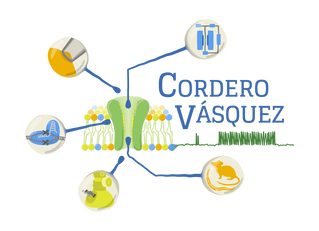Ion Channel GatingIon channel gating is a process defined by molecular transitions between conductive and nonconductive conformations that occur through structural rearrangements along the permeation pathway. Gating can be achieved by a variety of stimuli including transmembrane voltage, extracellular and intracellular ligands, membrane composition, fatty acids, temperature, and force. This assortment of stimuli governs the ionic flux required to accomplish the channels' respective physiological roles. Ion channels can be activated by single or multiple stimuli, the latter functioning as polymodal signal integrators. The transduction mechanism(s) used to integrate stimuli is one of the most intriguing questions in membrane protein physiology. We are designing experiments to investigate the molecular basis by which different stimuli induce protein motion, ultimately promoting channel gating and ion permeation.
|
Exploring sensory ion channel gating mechanisms will allow us to provide fundamental insights into channels' physiological roles and to help develop new therapeutic agents.
|
Transient Receptor Potential ChannelsSensory receptors convert physical and chemical stimuli into electrical signals that render individuals capable of detecting ambient and/or noxious temperatures, touch, pain, endogenous or environmental irritants and changes in blood pressure. The transient receptor potential (TRP) channel superfamily is a diverse family of cation channels that mediate a variety of physiological processes essential to eukaryotes (e.g., electrical activity, signal transduction, sensory perception, nociception, cardiac excitability, blood pressure regulation, and neurogenic inflammation); as such, they are important subjects for detailed mechanistic investigations. Genetically inherited mutations as well as other sources of protein dysfunction in TRP channels underlie numerous pathological conditions including inherited pain syndromes, kidney and bladder diseases, skeletal and smooth muscle disorders, neuropathic pain, asthma, and pruritus (itch). Thus, biophysical characterization of these membrane proteins represents a major goal in the development of therapeutic agents. Together with understanding the gating mechanism, we are motivated to study how disease-associated mutants alter the biophysical properties of TRP channels and provide insight into molecular mechanisms underlying normal and pathological conditions.
|
|
Mechanosensitive Ion Channels
Mechanosensitive (MS) channels are membrane proteins that transduce mechanical forces into electrical signals that ultimately lead to physiological or perceptual responses. These proteins allow us to be aware of our surroundings, keep balance control and locomotion, communicate, and maintain homeostasis. Even though many conditions and diseases (e.g., impaired proprioception, chronic pain, deafness, cardiac arrhythmias, hypertension, stroke) are associated with MS channel malfunction, our progress in understanding the molecular nature of eukaryotic mechanosensory transduction is still in its infancy. Unlike other ion channel families, MS channels do not necessarily share a common topology, making it rather difficult to identify homologs by sequence similarity. Thus far, there are five classes of membrane proteins proposed to form MS channels in eukaryotes: amiloride-sensitive sodium channels (DEG/ENaCs), transient receptor potential channels (TRPs), two-pore domain K+ channels (K2Ps), Piezo proteins, and transmembrane channel–like proteins (TMCs).
|
Particularly, in the C. elegans touch receptor neurons (TRNs) and mammalian inner hair cells it has been discovered that MS channels act as part of multisubunit complexes (e.g., MEC proteins in TRNs and TMCs, THMS, cadherins, and protocadherins in inner hair cells). The focus of our research is to understand the mechanism by which force triggers eukaryotic MS channels and how it alters the interaction between the pore, auxiliary subunits, and the membrane to give rise to mechano-dependent gating.
|

